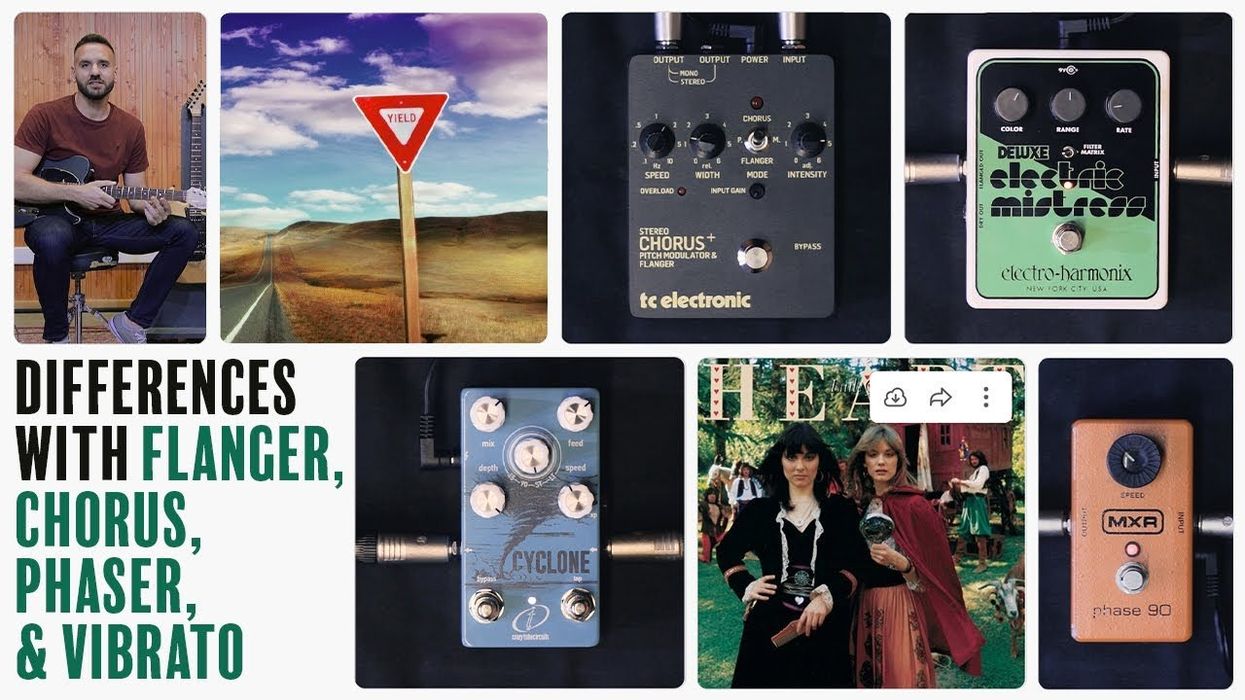PG's Nikos Arvanitis explains and demonstrates the individual sonic qualities and contrasting characteristics of the most-used modulation effects on guitar by citing the Police, Heart, Prince, Nirvana, Whitesnake, and Pearl Jam.
All 9V blocks are not created equal. Here's what to look for to avoid hiss, hum, and crackle.
(Originally published April 22, 2020)
At the dawn of the guitar-effects age, powering pedals was relatively simple. If an effects pedal didn't take a standard 9V battery like your AM transistor radio, it plugged into the wall like your avocado-green toaster. Forever dissatisfied, guitar players eventually grew weary of changing batteries, and plugging stuff into the wall was kind of a drag, too.
As the industry was looking to eliminate its batteries and Edison plugs, the effects purveyor Boss went a long way to standardizing pedal power by putting a 2.1 mm coaxial power jack on all their pedals, and while their market dominance made the 1/8" jack on certain Ibanez and Pro Co pedals outliers, even they couldn't stick to one standard for long as they transitioned from 12V ACA spec pedals to 9V PSA spec pedals.
Once that growing pain subsided, it was relatively peaceful on the pedal-powering front for many years, and the standardization allowed companies to produce power supplies that let players power all their pedals simultaneously and without harming a single battery. Some supplies had a single output with daisy chains to fan out power to multiple pedals. Some were isolated, offering an individual power port for each pedal and eliminating daisy-chaining all pedals in a parallel fashion. Isolated supplies were a huge development in pedal-powering history, so let's dig in there before wading further into the power morass of today.
In this context, isolated power supplies are those supplies that are essentially a series of separate power sources in one enclosure. Each supply stands on its own with no direct connection to any of the other supplies, and, as such, the effects they power have no direct connection to one another through their respective power ports.
There are several reasons power supply isolation can be anything from favorable to crucial. First, some pedals have a positive-ground scheme, where the audio ground of the effect is connected to the positive terminal of the battery, usually due to the type of transistors used in the pedal's circuit.
Isolated power supplies are those supplies that are essentially a series of separate power sources in one enclosure.
While fuzz pedals are often set up this way, most pedals have a more conventional negative-ground scheme. If you parallel connect the power of a positive-ground pedal to a negative-ground pedal, and then connect their audio grounds together with a patch cable, you'll cause a power supply short, and neither pedal will get power. The power source will complain, too! Isolated supplies mimic a battery as each device gets its very own power source to use independently of any other device.
Crosstalk is another reason for isolation. Some pedals don't play well with others when powered in parallel. Like so many playground bullies, tremolos and vibratos can tick and pop while overdrives and DSP effects with switch-mode supplies and high-speed processors can whine, and they can torment their boardmates with their glitches. These deficiencies might not bother the offending pedal, but the trash they put on their power supply ports gets leaked to other connected devices that may not be able to reject the noise quite as well. Isolation breaks the link and prevents such crosstalk.
The last reason for isolation we'll list here is ground loops. In general, for guitar rigs, it's best practice to have just one ground path. Typically, that one path should be the ground connections of all of your patch cables extending in a line from guitar's output to amp's input. Daisy-chaining power creates other ground paths that make closed loops from one section of your signal flow to another. These ground loops can make your rig more susceptible to hum pickup in the presence of electro-magnetic fields. If you have daisy-chained pedals both in front of an amp and in its FX loop, and dozens of feet of cable between them, the associated ground loops can become very large and produce a great deal of noise. Using an isolated supply disconnects the links that make the loop, and the induced hum can no longer be sustained.
With isolation addressed, power supplies remained relatively unchanged for many years. Then, digital-signal processing became cost-feasible for common use in guitar-pedal effects. We'll dig further into their high-current demands and how they've complicated the power supply marketplace in my next column.
Note the two trimmer screwdriver slots, surrounded by blue, in the middle of this phase shifter.
Aisha Loe explains how to cure mushy modulation with a screwdriver—but you need to know what you’re doing.
Potentiometers are used for most of the controls on pedals and a lot of other electronic equipment as well. A potentiometer (also known as a pot) is defined as a 3-terminal variable resistor in which the resistance is manually varied to control the flow of electrical current. A potentiometer acts as an adjustable voltage divider. Any control on a guitar pedal that has a knob will typically be controlling a potentiometer, or sometimes a rotary switch.
There is a type of potentiometer called a trimmer (also known as a trimpot) that lives inside of some stompboxes. It typically doesn’t have a shaft that sticks up like a regular potentiometer. Trimmers usually have a slot on top for making adjustments with a small screwdriver. They are meant to be set correctly when installed in a device, and mostly never seen or adjusted by the device’s user. Trimmers can be variable resistors, variable capacitors, or trimmable inductors, and they can perform many different types of functions within a circuit.
“I know what an epiphany it can be to unlock that little extra bit of magic out of an already beloved pedal.”
I get a fair amount of questions about trimmers—often: “Is it okay to mess with that?” There are many pedals on the market that have internal trimmers that can be adjusted by users, to tweak to personal taste. It is handy to be able to dial a sound in all the way, almost like fine-tuners on a guitar. Typical user-tweakable micro controls are for modulation speed and/or width, gain, and sensitivity.
Conversely, there are trimmers built into circuits that I would not consider easily user-adjustable. These include things like bias for time-based effects and setting proper voltages so circuits can function as they should. I’ve repaired quite a few analog delays and flangers, for example, that were perfectly functional! The bias had simply drifted out of its sweet spot. Perhaps the user had gotten too curious and decided to tweak those irresistible little trimmers? Or, more often than not, the trimmers had simply drifted a bit away from their set positions over many years of use, not to mention jostling from being transported to and from gigs. A qualified pedal tech has the right meters and test equipment to get those effects dialed right back in. However, bias can be a nightmare to get back to where it needs to be without some expertise. I understand why these folks thought their pedals were broken. A modulation effect that isn’t properly biased can sound absolutely horrible!
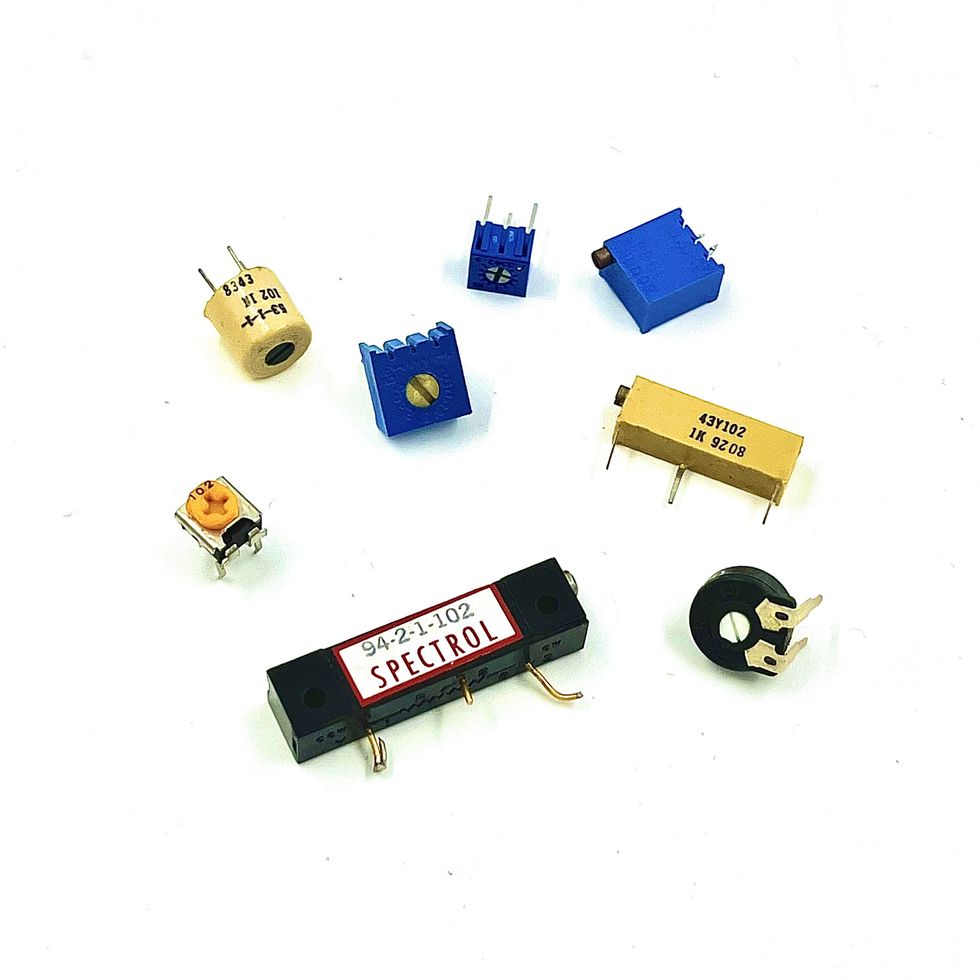
Internal timmers, aka trim pots, come in a variety of shapes and sizes. Look for the slots.
It’s only natural to be curious about the guts inside pedals. Trimmers can add so much extra versatility to a device. If you’re ever unsure which ones are okay to tweak, a good rule of thumb is to ask the builder or the company that makes a particular unit which of its trimmers are okay to fiddle with before you twiddle. In some cases, your warranty could be voided if you do adjustments, so it’s always a good idea to check first.
I know from my own playing what an epiphany it can be to unlock that little extra bit of magic from an already beloved pedal, and I enjoy sharing any knowledge that can help guitarists get the sounds that are most pleasing out of their effects. Perhaps that pedal you planned to trade could be transformed into something you really love with a little twist of a trimmer.
A Deeper Dive
I mentioned resistors several times in this column. A resistor is a passive, 2-terminal electrical component that controls electrical resistance as a circuit element. In electronic circuits, resistors are used to reduce current flow, adjust signal levels, to divide voltages, bias active elements, and terminate transmission lines, among other uses.
- Does your favorite stomp have an adjustable trimmer? You can find a list of popular guitar pedals that have adjustable trimmers here.
- To read more about voltage dividers, and how a potentiometer works, check this article out.
- And here’s some great information about trimmers, for further exploration.
Here we go again! Last month we brought you part one of your guitar cohorts’ boards from around the world. Time to dig in for part two.
Premier Guitar’sannual feature gives readers the chance to show off their pedalboards. There are so many ways of thinking when it comes to wiring up your effects—that’s the fun of it! In this round we’ve got a tribute to Eddie Van Halen, a pandemic board from Amsterdam, a maximalist stomper with 17 pedals, a curly cord “board,” and much more. Go forth to discover new pedals, and stomp on!
Aaron Costello: A Waylon Button
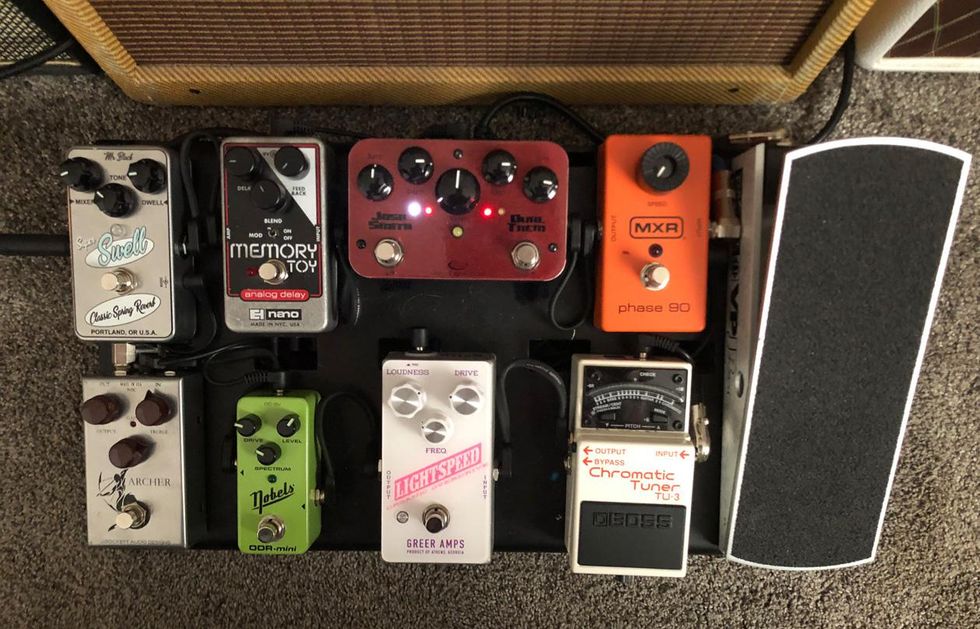
I live in Portland, Oregon. When I built this board, the goal was to get a clear, natural, amp-like sound, with multiple gain stages. Lots of trial and error (which was fun), and, after laboring over decisions that are of absolutely no consequence to productive society, here’s what I came up with.
1. Ernie Ball VP Jr.
Basic as it gets. I use it to quiet the rig when I play with acoustic instruments and am also trying to get the hang of pedal-steel bends. Still have some work to do there!
2. Boss TU-3
The standard.
3. Greer Amps Lightspeed
This thing is killer. With a single-coil guitar, I use it to push the Nobels ODR-Mini and get a little more gain without losing clarity. Typically, I use it for a raunchy rhythm sound. With a humbucker guitar, I usually shut the Nobels off and use it by itself.
4. Nobels ODR-Mini
This is my favorite pedal and the heart of the board. It’s very much like an amp. With a single-coil guitar, I use it for my clean sound and it’s always on. I really dig the edge-of-breakup thing.
5. J. Rockett Audio Archer
I like this behind the Nobels and use it to get a “singing,” higher-gain lead tone. Again, it retains the clarity at higher gain but still sounds like an amp.
6. MXR Phase 90
I literally call this the “Waylon Button.”
7. J. Rockett Audio Josh Smith Dual Trem
I don’t use it a ton but sometimes it’s the perfect thing to add color. Sometimes I’ll use it with the Greer and then fade it in and out with the volume pedal. It lets me mimic an organ pad and is kind of fun.
8. EHX Memory Toy Mini
This is my second favorite pedal. I use it for a slapback sound and it’s almost always on.
9. Mr. Black Super Swell Reverb
My main amps are a 1975 Princeton Reverb and a 1978 Vibrolux Reverb, so I usually like the amp reverb. I do have a couple of amps in my home studio that don’t have reverb, so I use this with those. It also sounds great on bass!
10. Voodoo Labs Pedal Power 4x4
This is under the board and does the job. Thanks for reading!
Bert Harris: My Curly “Board”
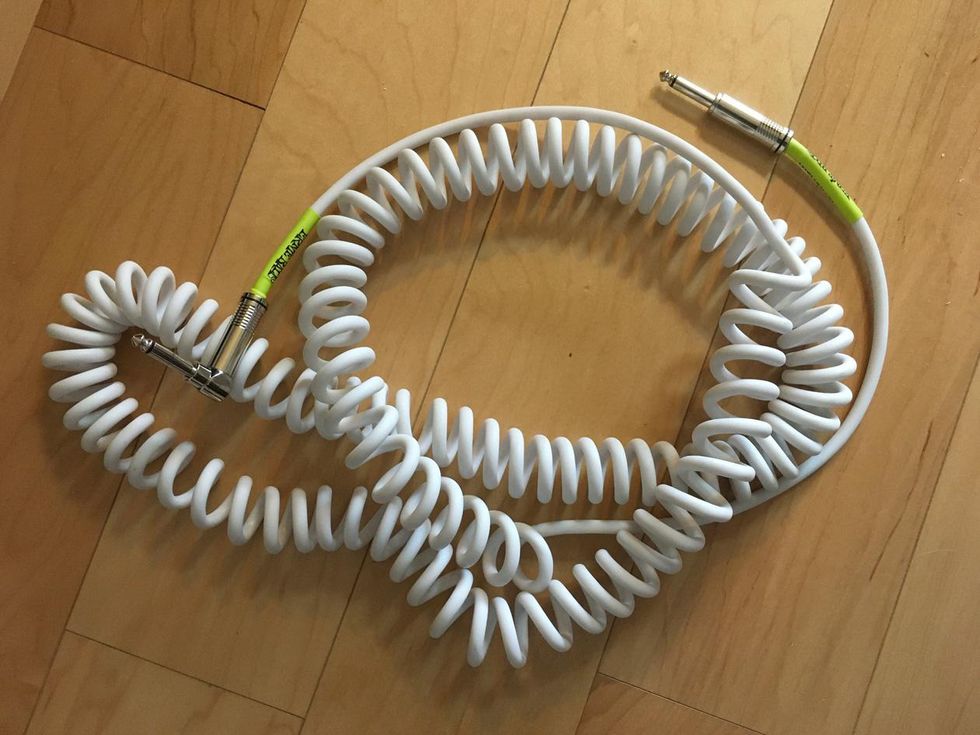
Here’s my pedalboard … I prefer to plug straight in and get all my tone from the amp itself. Nothing cooler than Clapton with a white curly cord plugged directly into a Fender Dual Showman at The Rolling Stones Rock and Roll Circus! I love the thought of showing up with a guitar, amp, pick, and curly cord!
Admittedly, I’m kinda lazy and plugging in a bunch of stuff is a beating to me … although I have been using an Xotic EP Booster lately, but it’s battery powered. Hope your day is a wonderful one!
Brian Schwager: Short and Sweet
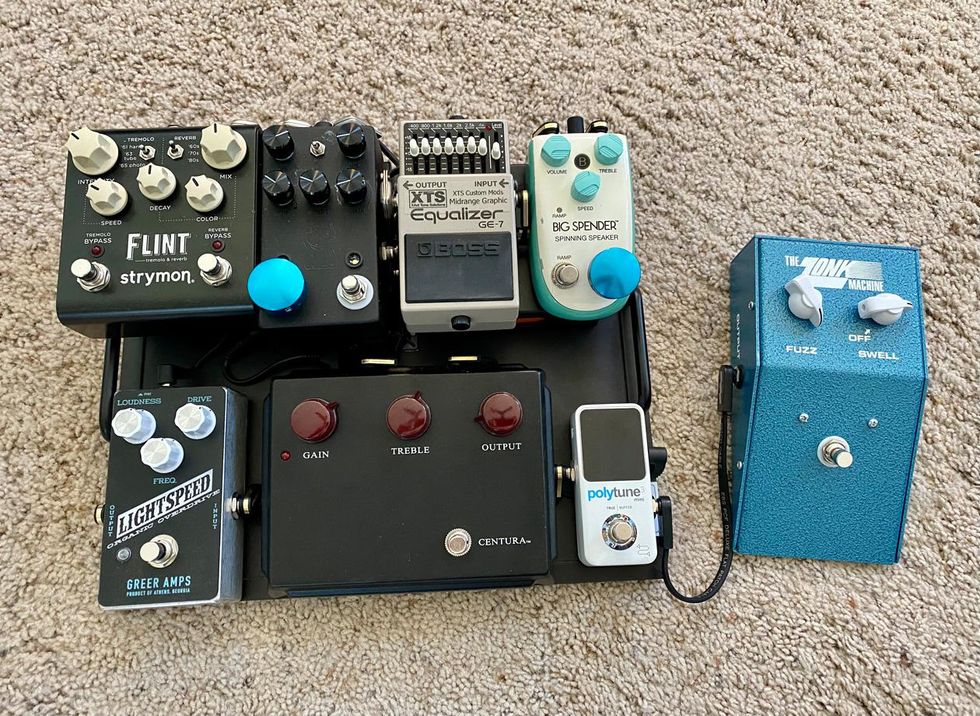
Hello, I play in multiple bands in Des Moines, Iowa. Here’s what I got goin’ on my pedalboard:
- British Pedal Company Zonk Machine
- TC Electronic PolyTune 3 Mini
- Ceriatone Centura
- Greer Amps Lightspeed
- Danelectro BillionaireBig Spender Spinning Speaker
- Boss (XTS Custom Mods) GE-7 Equalizer
- JHS Pedals Lucky Cat Delay
- Strymon Flint
- Lehle P-Split (under the raiser, top right)
Drew Smith: Three is the Magic Number
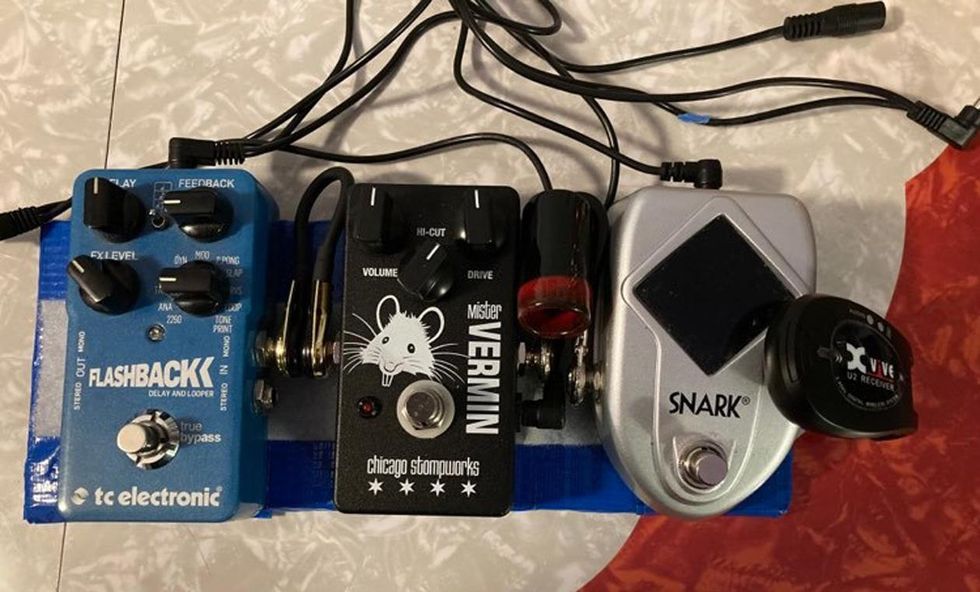
I love these reader pedalboards: I hope you feature my board! I’m in a psychedelic punk-blues duo called Phantom Ocean, based out of New England. We’re heavily indebted to alternative music from the ’80s, ’90s, and early 2000s, and because there’s only two of us, my wife on drums and me on guitar, I keep my rig pretty tight. I need a few solid guitar tones and tend not to dip into too much modulation. To that end, my board right now only has three pedals: tuner, dirt, and delay.
For a tuner, I’ve got a Snark because it’s economical and does the job right. For dirt, I’ve got a Chicago Stompworks Mr. Vermin, their version of a Pro Co RAT, and it’s the best RAT I’ve ever tried. The first time I plugged into this thing, I finally understood why the RAT is so beloved by so many guitarists whose ears I respect. It really covers such a broad swathe of tones, from overdrive to straight-up fuzz. And then the TC Electronic Flashback is my favorite delay. I’ve never had one fail on me, you can get such a variety of sounds, and the TonePrint feature is always there to craft something really wild.
I round the board out with an XVive U2 wireless system, because I hate accidentally dragging cables across my board and freedom of movement onstage is a joy (even if I spend half the set near the mic anyway). I also use one of (Premier Guitar Senior Editor) Ted Drozdowski’s Rocky Mountain signature slides for my slide-guitar work.
Ernie Santella: Does-It-All Board
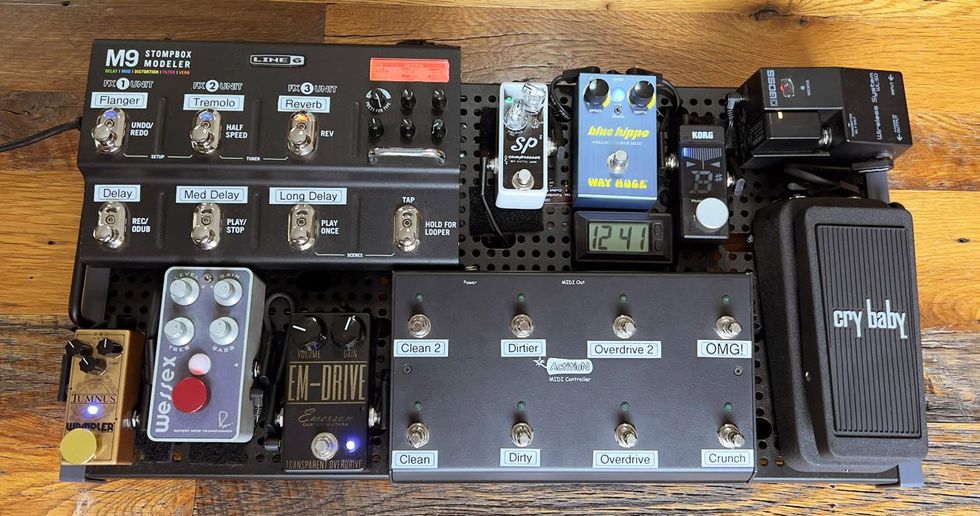
I built this pedalboard for my classic-rock cover band Wasted on the Young, out in Colorado. We cover everything from Bonnie Raitt to Stevie Ray Vaughan to ZZ Top to Maroon 5. So, I had to have a pedalboard that would fit just about anything our band needed to play. I think I achieved that. I have it all right underfoot at all times. I’m old-school and wanted to stay analog for the input side and then just a little digital on the effects loop side to keep the size down and give me the most bang for the space. I used a few mini pedals, but only if they sounded as good as their larger brethren.
I run my guitars (Heritage H-150, RS Guitarworks T-Style and S-Style, PRS Custom 24) with a single wireless. The Boss WL-50 is nice and clear-sounding with long battery life. Best part is, it auto-mutes when you unplug it, allowing for faster, noiseless guitar swaps.
The board is a Temple Duo 24, which is a great size and not too gnarly to carry. The wireless goes into the Dunlop Cry Baby Junior Wah (a classic-sounding wah with a slightly smaller size), then into the Korg Pitchblack, which is a nice and bright LED tuner, even outdoors. The tuner feeds the Xotic SP Compressor for some clean spank when needed. Next are three pedals for different levels of boost. Depending on the amp setting, the three boosts work differently. The Emerson EM-Drive is great for a quick Marshall-in-a-Box crunch tone. The Bogner Wessex is my over-the-top overdrive that has a nice compression to it. Lastly, the Wampler Tumnus is a Klon killer and is great for adding clean lead boost to anything, just by adding level and not too much gain.
I run that into a Hughes & Kettner GrandMeister 36 head. The amp is all analog, but digitally controlled by MIDI. So, technically, you have 128 amp presets. I use a cheap ActitioN 8-button MIDI controller I found on Reverb for amp presets. From spanky clean to OMG gain. It’s like having an 8-channel amp! I can just step through 8 levels of gain in increments.
The effects loop of the amp feeds the Way Huge Smalls Blue Hippo set to the Joe Bonamassa-approved chorus setting that gives a killer rotary-speaker tone. Then, into the Line 6 M9 for chorus, tremolo, flange, and spring reverb for the many different tunes we play. Lastly, the clock for keeping us on schedule during a gig. We’ve been known to jam out and forget the set schedule! Hope you like it!
Fernando Diaz: Clean, Mean Maximalist
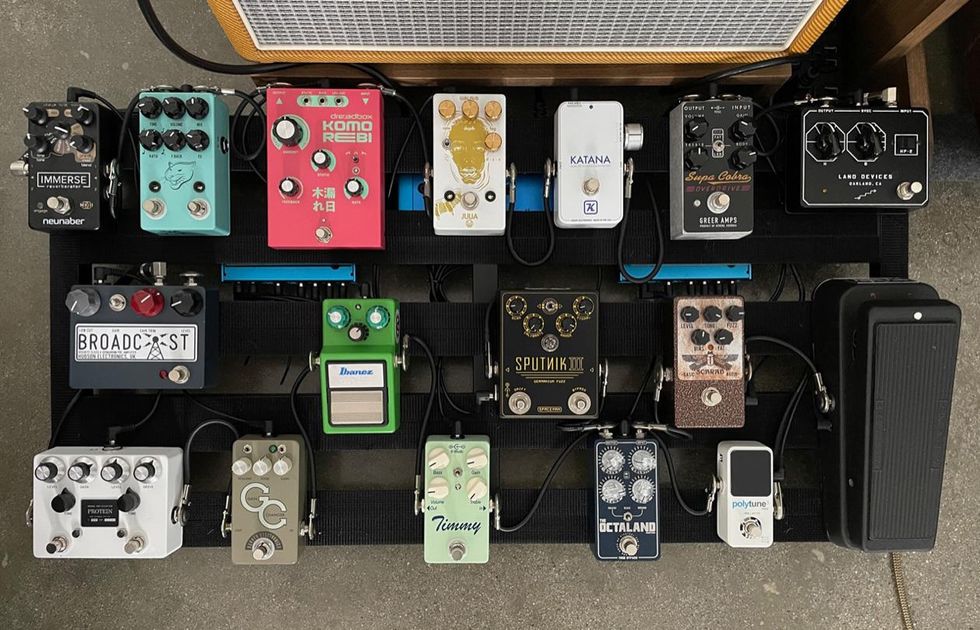
Greetings! Here is the current iteration of my pedalboard. It’s powered by a Strymon Zuma, and two Strymon Ojai expansion kits.
The chain is as follows:- Dunlop 535Q Cry Baby Multi-Wah
- Basic Audio Scarab Deluxe
- King Tone Octaland Mini
- Spaceman Sputnik III
- TC Electronic PolyTune 3 Mini
- Paul Cochrane Timmy
- Ibanez TS9 Tube Screamer (with Alchemy Audio mod)
- Browne Amplification Protein
- Barber Electronics Gain Changer SR
- Hudson Electronics Broadcast
- Land Devices HP-2
- Greer Amps Supa Cobra
- Keeley Katana Boost
- Walrus Audio Julia V1
- Dreadbox Komorebi
- JHS Pedals Panther Cub V2
- Neunaber Immerse Reverberator Mk II
Jelle Veirman: Booze Protected
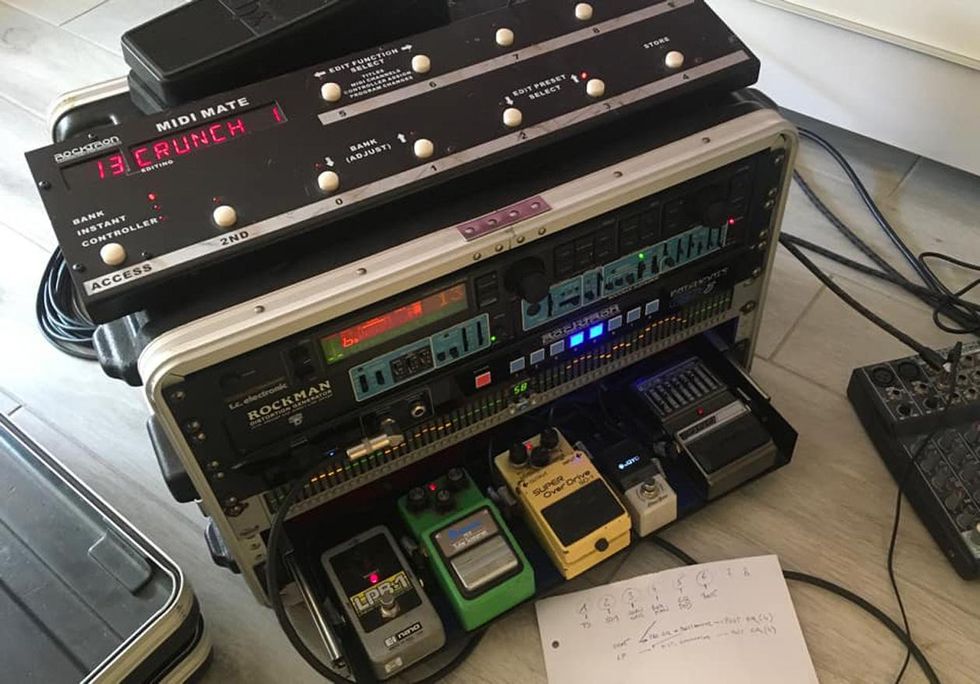
This is the gear I use almost daily, playing a wide range of genres in different cover bands, from classic rock to contemporary music. I had to figure out a way to get the most out of my Stratocaster and Les Paul through one compact system and protect my gear against drunk people and their booze.
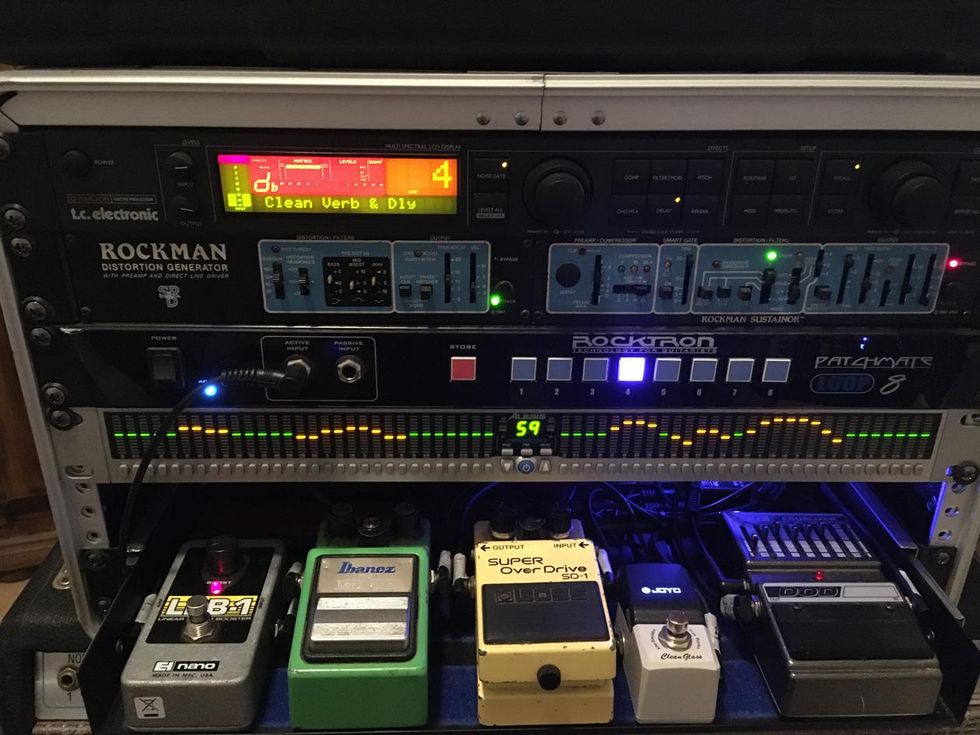
This is my rack configuration:
Electro-Harmonix LPB-1 Linear Booster, Ibanez TS9 (overdrive for the Strat), Boss SD-1 (overdrive for the Les Paul), Joyo Clean Glass preamp, DOD FX40B Equalizer, Rockman Sustainor (Strat crunch and leads), Rockman Distortion Generator (Les Paul crunch and leads), Rocktron Patchmate Loop 8, Rocktron MIDI Mate, Electro-Harmonix Expression Pedal, Dunlop Cry Baby Wah, TC Electronic G-Major effects processor, Alesis DEQ 2-channel Equalizer (pre- and post-Rockman EQ), and a Mooer Macro Power Supply. Going into the effects return (power amp) of my Fender Hot Rod Deluxe III.
JR Emmett: String Monkey
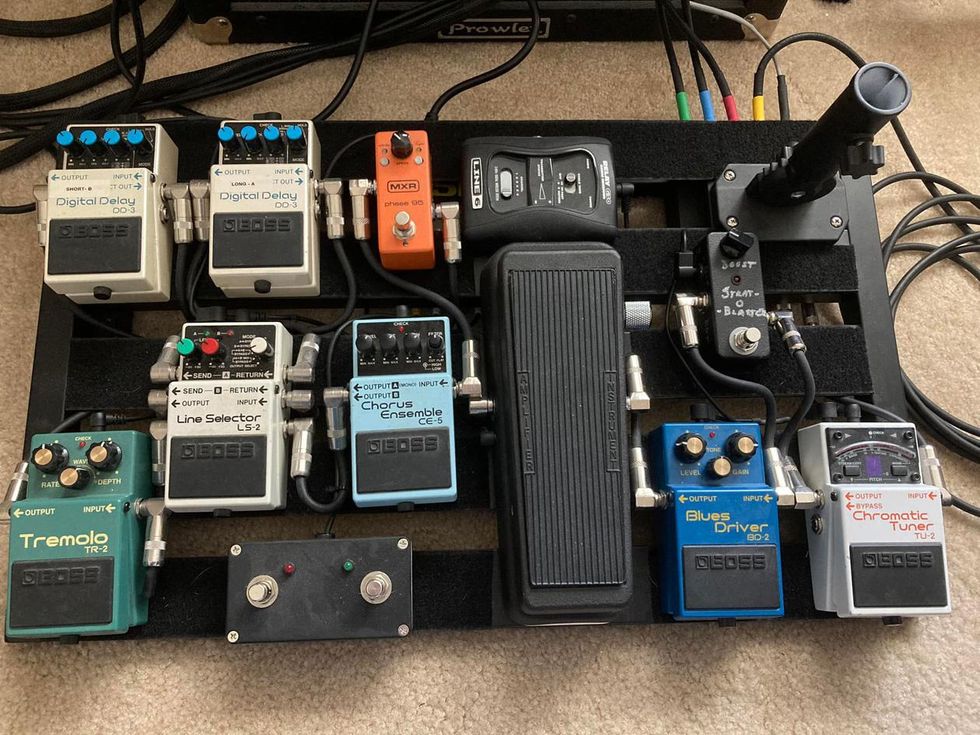
This is my humble submission for your Reader Pedalboard feature. This is my personal board, which serves as a demonstrator to my clients of what can be done with a pedalboard to make it convenient and versatile as well as supporting my own practice and performance needs. When I’m not playing guitar, I’m a one-man shop (String Monkey Technical Services) providing guitar repair and custom fabrication services to the North Texas music community.
Signal chain:
Wireless or cable -> Boss TU-2 -> General Guitar Gadgets Stratoblaster -> Boss BD-2 Blues Driver -> Dunlop 535Q Multi-Wah -> amp input
Amp FX send -> MXR Phase 95 -> Boss CE-5 Chorus -> Boss LS-2 (mixes signals from two Boss DD-3 Digital Delays run in parallel) -> Boss TR-2 Tremolo -> amp FX return
Other Features:
- Pedaltrain Novo 24 board
- Truetone 1 SPOT Pro CS7 Power Supply
- Built-in mic stand holder (upper right, repurposed flagpole mount)
- String Monkey patch bay with color-coded loom for easy signal hookup
- String Monkey repackaged amp-channel switcher (original was too big)
- String Monkey acrylic wah baseplate with mechanical clamp to Pedaltrain rails
- Talent DI Box with cabinet simulator and patch cables for direct to PA connection
- Soldered interconnect using Mogami bulk cable and Switchcraft phono plugs
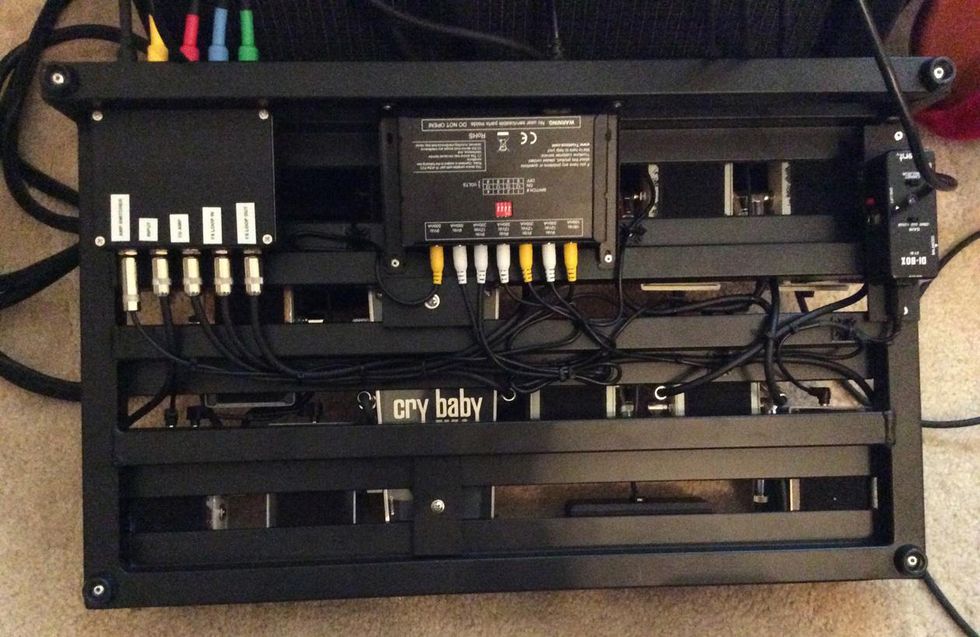
Keith Paul: Bass Board
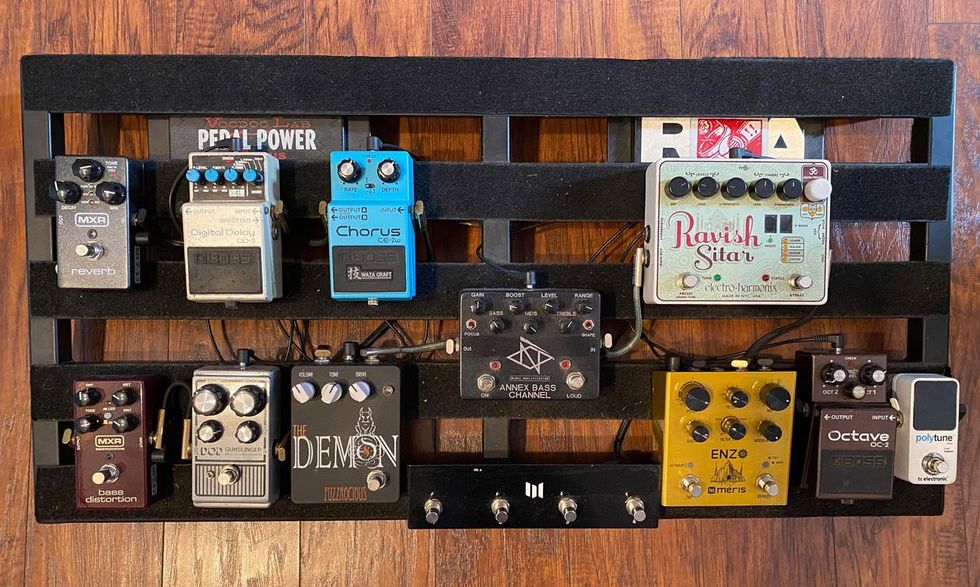
Hello PG! I just wanted to share my bass pedalboard that I use in my band Dumb Waiter, from Richmond, Virginia. Keep up the great content, I love the Rig Rundowns! Stay well.
Signal Chain:
- TC Electronic PolyTune Mini
- Boss OC-2 Octave
- Meris Enzo with preset switch
- Electro-Harmonix Ravish Sitar
- Nunez Amps Annex Bass Channel
- Fuzzrocious The Demon
- DOD Gunslinger
- MXR M85 Bass Distortion
- Boss CE-2W Chorus
- Boss DD-3 Digital Delay
- MXR M300 Reverb
Marco Fumagalli: Pandemic Pedalboard
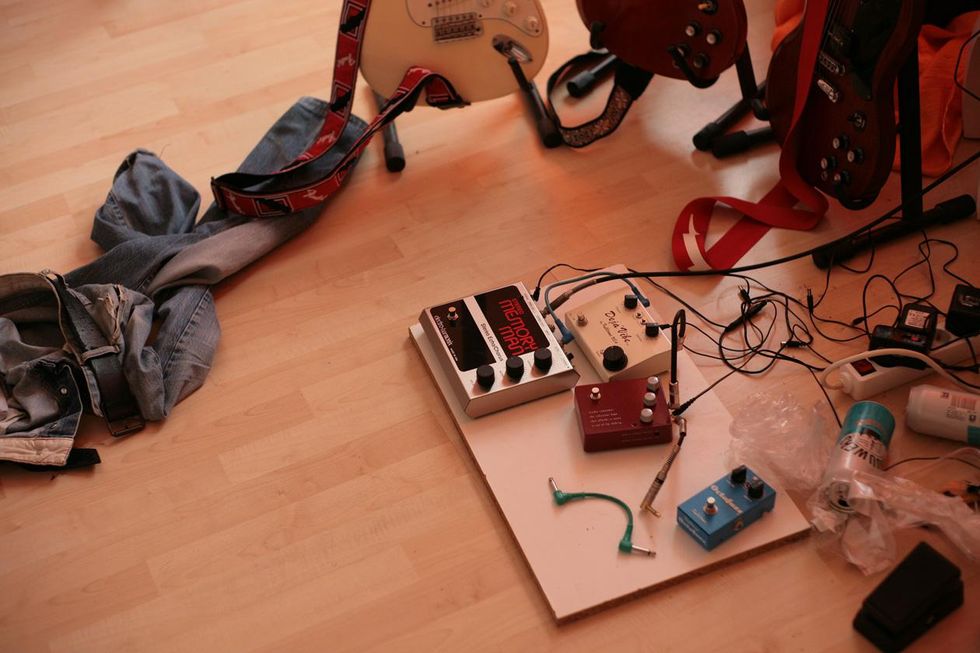
I am from Italy and living in Amsterdam, Netherlands. This is my pedalboard during the first wave of lockdown in 2020. I used to play in bands, but now I do it for my own pleasure. Playing the guitar and shaping the sound of it is a way for me to escape and relax. I don’t really play a specific type of music, but my root is blues.
Pictured: Electro-Harmonix Stereo Memory Man, Fulltone Mini Deja’Vibe, Klon KTR, Fulltone Octafuzz, Dunlop Cry Baby Mini Wah, two Gibson SGs, and a ’97 Fender Voodoo Strat from the greatly missed Mr. Soren Venema of the legendary Palm Guitars shop in Amsterdam.
Raghav Govindarajan: Nerding Out

I’m a huge fan of the Premier Guitar platform. My boss at the music school I work at and I frequently nerd out over the Rig Rundowns, so thank you for that! Figured I’d toss my pedalboard up. I have decided to update it since this photo, but my new pedals won’t be in until next week most likely.
The pedal chain from right to left is:
- DigiTech Drop
- Wampler Ego Compressor V2
- Dr. Scientist The Elements Distortion (Gold Bar Edition)
- Wampler Pantheon Overdrive
- Boss EQ-200 Graphic Equalizer
- Swindler Effects The Gulf Chorus V2
- Strymon Iridium
- Source Audio Collider Delay+Reverb
The output of the Wampler Ego goes into input A of the EQ-200, and output A goes into the Elements. The output of the Pantheon goes into the input B of the EQ-200, and output B goes into the Iridium. This lets me shape my sound pre- and post-gain.
Thanks for letting me nerd out about my board for a few minutes! And thank you for all that you do for the guitar community and musicians. Rig Rundowns really are the best part of my week/month and I love discovering new artists and players from it. It’s like the guitar player’s NPR Tiny Desk!
Robby Hovie: Going North
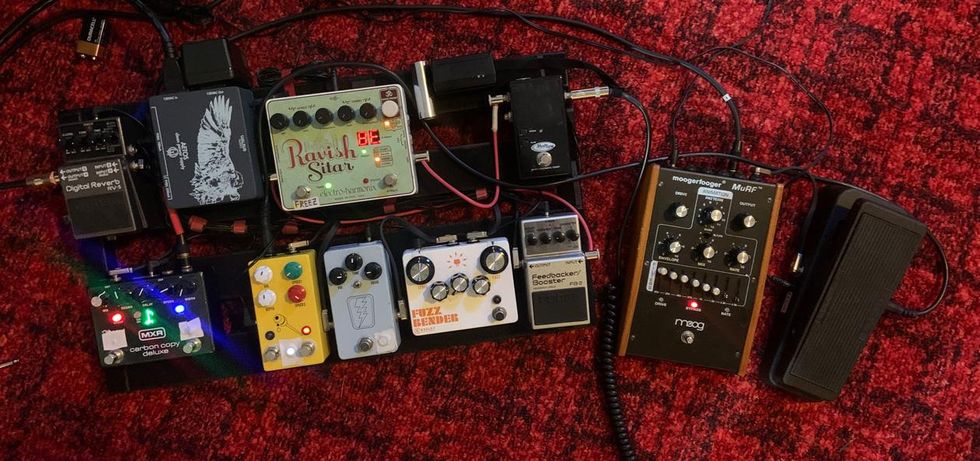
Greetings from Northern Michigan! Here’s my rig for my work in the band Levitator. Thanks!
In order:
- Modtone MT-PT1 Chromatic Tuner
- Electro-Harmonix Ravish Sitar
- Boss FB-2 Feedbacker/Booster
- Keeley Fuzz Bender
- JHS Pedals SuperBolt V1
- JHS Pedals Honey Comb Deluxe
- Dunlop Cry Baby Wah
- Moog MF-105 MoogerFooger MIDI MuRF
- MXR Carbon Copy Deluxe
- Boss RV-5 Digital Reverb
Sebastian DiPietro: The Full Package
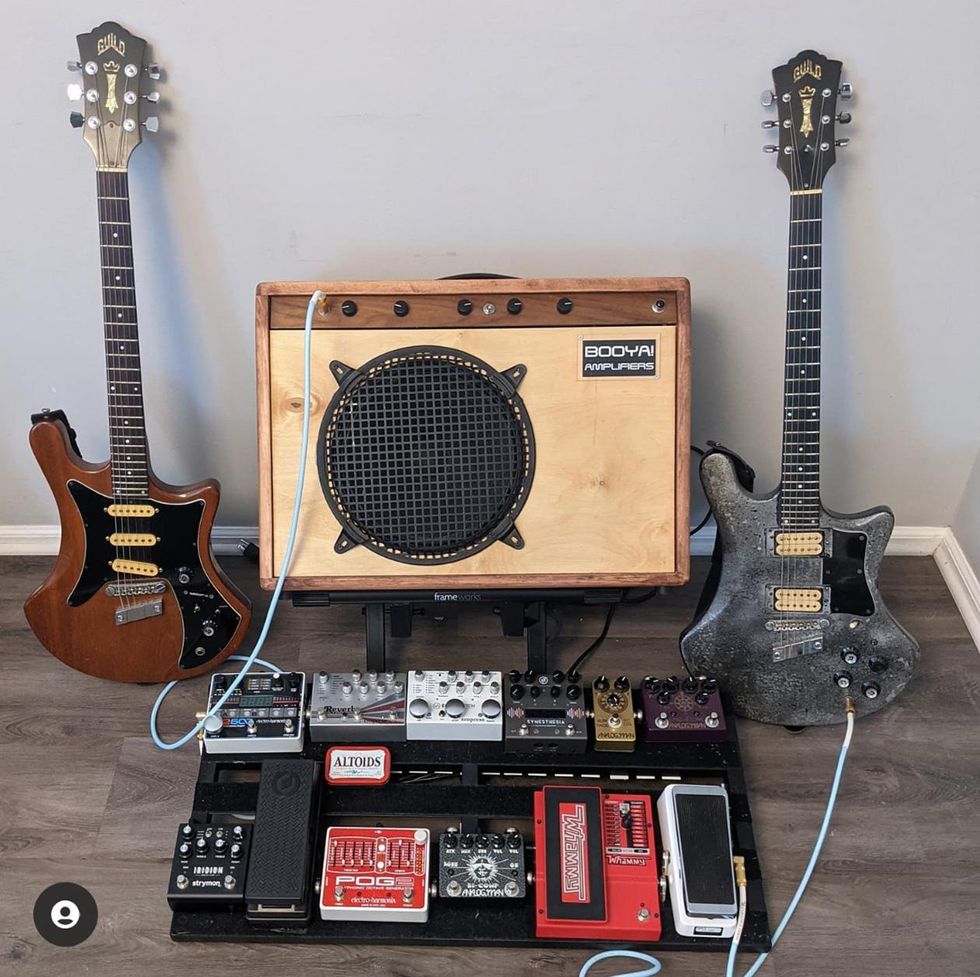
Here is a picture of my pedalboard, along with my amp and guitars, to give a complete view of my rig.
Pedalboard:
Xotic XW-1 Wah -> DigiTech Whammy V -> Analog Man Bi-CompROSSor Rev5 -> Electro-Harmonix POG2 -> Analog Man King of Tone -> Analog Man Sun Face BC109B -> GFI System Synesthesia -> Empress Effects Echosystem -> Empress Effects Reverb -> Electro-Harmonix 22500 Dual Stereo Looper -> Amp or Strymon Iridium
Guitars and Amp:
- Guild S70
- Guild S300D
- Booya! Amplifiers 27-watt combo with a Celestion G12H-75 Creamback
Cables:
- Caulfield Cables (light blue guitar/amp cables)
- Audioblast Cables (patch cables)
Steve Gorospe: All Styles
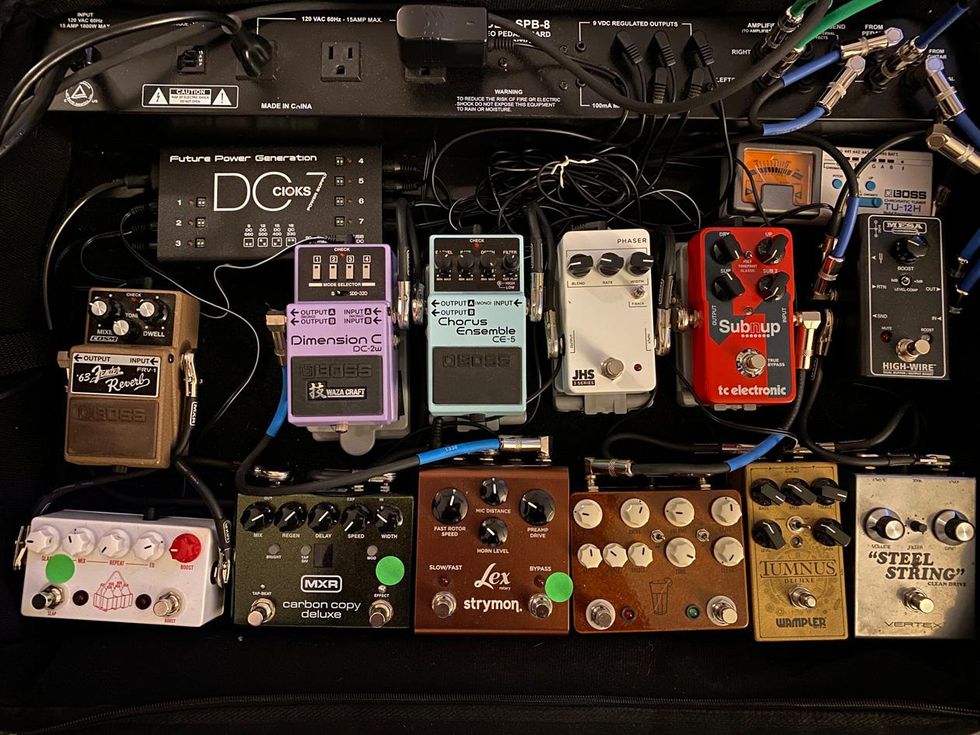
I play in the American Music Company Band covering songs from the 1940s to the early 1970s, with most of the focus on 1950s rock ’n’ roll and 1960s R&B and soul. But that also includes blues and some old-school country. I spent my teen years through the 1980s, so ’70s guitar rock and ’80s stadium rock are a huge part of my musical life. I built a pedalboard that works for me to cover all these styles and material.
Pedals in series in the order below:
- Vertex Steel String
- Wampler Tumnus
- JHS Pedals Sweet Tea V3
- TC Electronic Sub N Up Octaver
- JHS Pedals Series 3 Phaser
- Boss CE-5 Chorus Ensemble
- Boss DC-2W Dimension C Waza Craft
- Strymon Lex Rotary
- MXR Carbon Copy Deluxe
- JHS Pedals The Milkman
- Boss FRV-1 ’63 Fender Reverb
- Mesa/Boogie High-Wire Dual Buffer (input and output)
- Boss TU-12H High-Range Chromatic Tuner (hooked to the tuner output of the Mesa High-Wire)
Thomas Madera: Tribute to Eddie
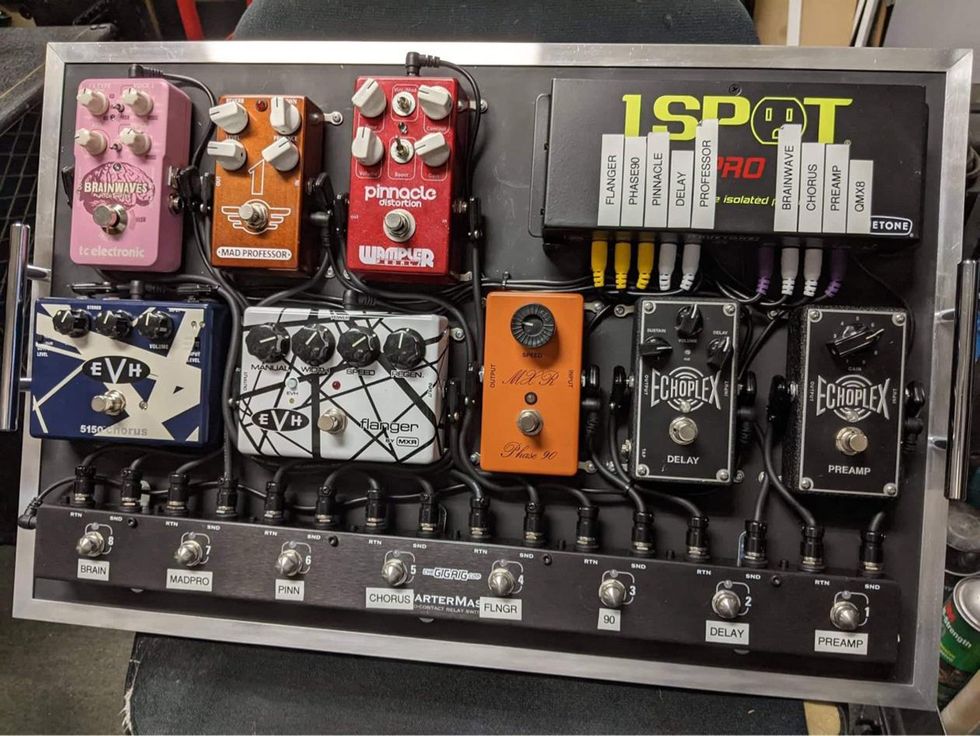
I’m a guitarist in Las Vegas, Nevada. My stompbox setup is mostly a tribute to Eddie Van Halen, but this board is great for tons of rock/metal tones, lead or rhythm. It includes: an Echoplex EP101 Preamp, Echoplex EP103 Delay, a reissue MXR Script Phase 90, MXR EVH117 Flanger, MXR EVH 5150 Chorus, Wampler Pinnacle Distortion, Mad Professor 1 Distortion/Reverb, and a TC Electronic Brainwaves Pitch Shifter. Everything is routed into a GigRig Quartermaster QMX 8 switcher and powered by a Truetone 1 SPOT Pro CS12.
Image 1: Impulse response reverbs like Audio Ease’s Altiverb excel at cloning real acoustic spaces.
The entire world of ’verb—from traditional to extreme—really does lie at your fingertips. Here’s how to access it.
This article is for recording guitarists eager to make the most of reverb plug-ins. We’ll explore the various reverb types, decode the controls you’re likely to encounter, and conclude with some suggestions for cool and creative reverb effects.
This is not a buyer’s guide, though you’ll hear many different products. Our focus is common reverb plug-in parameters and how to use them. Nearly all modern DAWs come with good-sounding reverbs. You can also add superb third-party plug-ins. But there are also plenty of free and budget-priced reverbs—just google “free reverb plug-in.”
Reverb = delay. Reverb is merely a delay effect. Sounds traveling through air eventually encounter surfaces. Some sound bounces off these surfaces, producing a complex network of echoes, made even more complex when the initial reflections bounce off secondary surfaces.
The controls on reverb plug-ins define how the software mimics this process. Function names can be confusing, but remember, everything relates to acoustic phenomena that you already understand intuitively. For example:
- The space’s size. (The further a sound travels before hitting a surface, the slower the echoes arrive.)
- The hardness of the reflective surfaces. (The harder the material, the louder, brighter, and more plentiful the echoes.
- The relative angles of the reflective surfaces. (A square room sounds different than a round one, which sounds different than a trapezoidal one.)
- The presence of other objects. (Soft surfaces like carpets, cushions, and acoustic foam diminish the reverb, usually affecting some frequencies more than others.)
- The listener’s location. (The further an ear or microphone from the sound source, the more reverberation is perceived.)
Understanding Reverb Types
By definition, all reverb plug-ins are digital. Most are either algorithmic or convolution-based. Algorithmic reverbs employ delay, feedback, and filters to mimic sounds bouncing around in space. Convolution reverb (also called impulse response or IR reverb) creates “snapshots” of actual sonic spaces and audio devices. In convolution, developers amplify a test tone in the targeted space (or through a target piece of audio gear) and record the results. The software compares the new recording to the dry test tone, and then it applies corresponding adjustments to any audio, making it sound as if it was recorded in the modeled space or through the modeled gear. (That’s how the speaker simulations work in most amp modelers.) Algorithmic and convolution reverbs often perform the same tasks, just via different methods.
But when we make musical choices, we rarely think, “This should be algorithmic and that should be convolution.” We’re usually trying to evoke a particular sound: a place, an old analog device, a freaky sound not found in nature. So, let’s take a whirlwind tour of reverb history, with thoughts about obtaining those sounds via plug-ins.
A Haul-Ass Reverb History
Real spaces. Before the 20th century the only reverbs were actual acoustic environments: caves, castles, temples, tombs. It wasn’t till the 18th century that people began constructing spaces specifically for their sonic properties—the roots of the modern concert hall.
Convolution reverbs excel at conjuring specific places. Most IR reverbs include libraries of such sounds. Some evoke iconic spaces and famed studios. IRs can also mimic small spaces, like a closet or compact car.
Clip 1 — A Guitarist’s Guide to Reverb Plug-ins by premierguitar
In Clip 1, you hear the same acoustic guitar snippet through IRs captured inside the Great Pyramid of Giza, the isolation block at Alcatraz prison, Chartres cathedral, and the interior of a VW Beetle, all using Audio Ease’s Altiverb library. (For demo purposes, reverb is applied rather heavily in all audio examples.)
Echo chambers were the earliest form of artificial reverb, though they aren’t all that artificial. The chamber is usually a room with hard, reflective surfaces. A loudspeaker in the chamber amplifies dry recordings, and a distant microphone records the results. It’s still “real reverb,” only it can be added and controlled independently from the original recording. This process evolved during the 1930s and ’40s. The first popular recording to use the effect was 1947’s “Peg o’ My Heart” by the Harmonicats, produced by audio genius Bill Putnam.
PEG O' MY HEART ~ The Harmonicats (1947)
During a recent recording session at Hollywood’s Sunset Sound, I shot Video 1 in the famed Studio A echo chamber, thanks to house engineer George Janho. You’ve heard this very room countless times. The Doors and Van Halen made most of their records here. You also hear this reverb on “Whole Lotta Love,” the vocal tracks on the Stones’ “Gimme Shelter,” Prince’s 1999 and Purple Rain, and countless other famous recordings.
Sunset Sound Chamber
Echo chambers are well represented in most IR reverb libraries. Most algorithmic reverbs do chambers as well, replicating the general effect without modeling a particular space. You can even find plug-ins dedicated to a specific chamber, like Universal Audio’s Capitol Chambers, which models the Hollywood chamber famously used by Frank Sinatra.
Spring reverbs. These were the first truly artificial reverbs. They initially appeared in pre-WWII Hammond organs, and by 1960 or so they had migrated to guitar amps. Fender wasn’t the first company to make reverb-equipped amps, but their early-’60s reverb units still define the effect for many guitarists.
The reverb effect is produced by routing the dry signal through actual springs, with a microphone capturing the clangorous results and blending them with the original tone. Springs generally sound splashy, trashy, and lo-fi, often in glorious ways. It’s an anarchic sound, best captured in a plug-in via IRs. Most of the spring reverb sounds in guitar modelers are IR-based. Meanwhile, reverb stompboxes—usually algorithmic—mimic the sound with varying degrees of success.
Plate reverb appeared in the late 1950s, initially in the Elektromesstechnik EMT-140, which remains a sonic gold standard. Plate reverb works similarly to spring reverb, but a massive metal sheet replaces the springs. It’s generally a smooth, sensuous sound relative to a spring.
Clip 2 — A Guitarist’s Guide to Reverb Plug-ins by premierguitar
In Clip 2, you hear the same acoustic guitar snippet through impulse responses of a Fender spring reverb unit and a vintage EMT-140 plate.
There are countless plate clones among today’s reverb plug-ins. Some are convolutions based on analog gear. But algorithmic reverbs also excel at faux-plate sounds. In fact, one of the initial goals of early digital reverb was to replace cumbersome mechanical plates. Speaking of which.…
Digital reverb (the algorithmic kind) arrived in 1976 via the EMT-250, also from Elektromesstechnik. Lexicon and AMS produced popular rivals. They focused largely on mimicking rooms, chambers, and plates. Sound quality has improved over the decades thanks to increased processing power and clever programming.
Today you can get far “better” algorithmic reverb from plug-ins. But ironically, those primitive digital ’verbs are trendy again in pop production. You can find precise clones of retro-digital hardware in plug-in form.
Convolution reverb debuted at the end of the century, popularized by Sony’s DRE S777 unit. Convolution reverbs often have fewer controls than their algorithmic cousins because most of the process is baked into the impulse response.
Most convolution reverbs have similar sound quality. The free ones can sound as good as the pricy ones. Higher prices are often based on the size and quality of the included IR libraries. Google free reverb impulse responses for gratis goodies.
Recent wrinkles. There are always interesting new reverb developments. For example, Things — Texture from AudioThings and Silo from Unfiltered Audio are anarchic granular reverbs that loop and manipulate tiny slices of the reverb signal to create otherworldly effects ranging from the brutal to the beautiful.
Clip 3 — A Guitarist’s Guide to Reverb Plug-ins by premierguitar
Clip 3 includes several granular reverb examples.
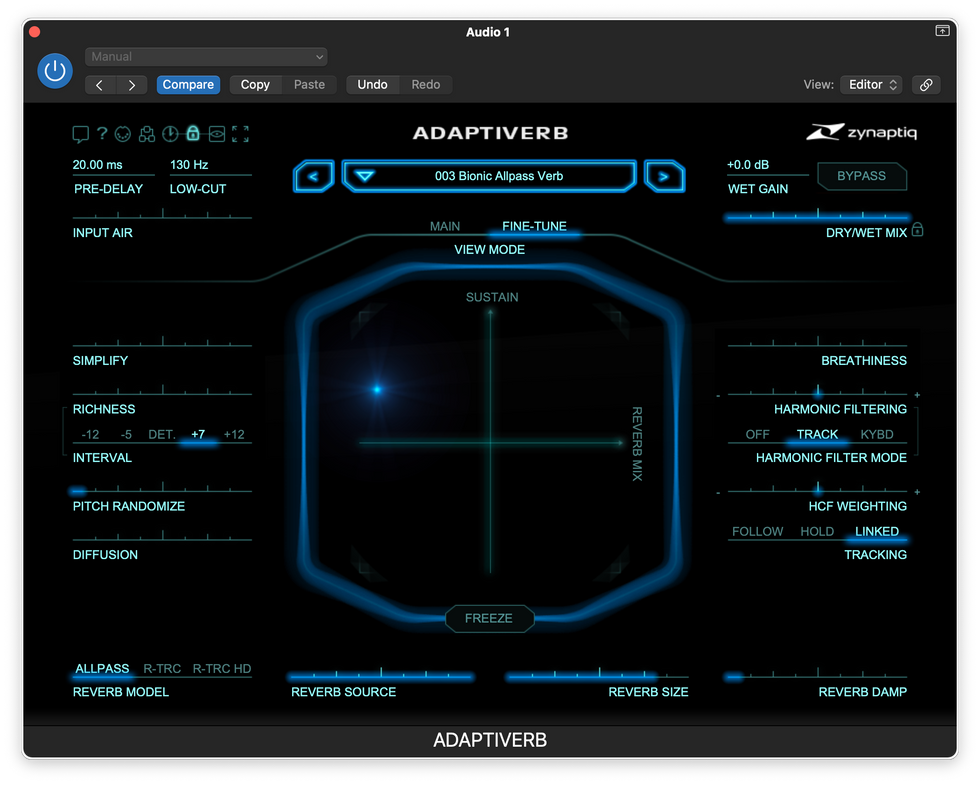
Image 2: Zynaptiq’s innovative Adaptiverb generates reverb via pitch-tracking oscillators rather than delays and feedback loops.
Some newer reverbs employ artificial intelligence to modify the effect in real time based on the audio input. iZotope’s Neoverb automatically filters out frequencies that can muddy your mix or add unwanted artifacts. And Zynaptiq’s Adaptiverb generates reverb in a novel way: Instead of echoing the dry signal, it employs pitch-tracking oscillators that generate reverb tails based on the dry signal. It, too, excels at radical reverbs suitable for sound design.
Clip 4 — A Guitarist’s Guide to Reverb Plug-ins by premierguitar
Clip 4 demonstrates a few of its possibilities.
Common Reverb Plug-in Controls
The knob names on a reverb plug-in can get confusing, but remember that they control variables that you already understand intuitively. Also, not all controls are equally important. The most essential ones are the wet/dry balance and the reverb decay time (how long it continues to sound). By all means learn the subtler functions, but don’t be surprised if you use them only rarely.
Video 2 walks you through most of the controls you’re likely to encounter on an algorithmic reverb plug-in. I used ChromaVerb from Apple’s Logic Pro DAW for the demo, but you’ll encounter similar parameters on most algorithmic reverb plug-ins.
Digital Reverb Walkthrough
Creative Reverb Ideas
Spring things. The single reverb knob on vintage amps is simply a wet/dry blend control. Some spring reverbs add a dwell control to set the amount of reverb input. Higher settings mean louder, longer reverberation.
But in the digital realm, you can deploy old-fashioned spring reverb in newfangled ways. For example:
- Pan the dry signal and spring sound apart for a broad stereo effect. (Traditional spring reverb is strictly mono.)
- Add predelay, inserting space between the dry and wet signals. (If the plug-in has no predelay control, just add the effect to an effect bus with a 100 percent wet, no-feedback delay upstream.)
- Route a guitar signal to two different spring reverb sounds, panned apart.
- Assign the reverb to an effect send, add a compressor to the effect channel, and then sidechain the compressor to the dry guitar sound. That way, the reverb is ducked when the guitar is loud, but swells to full volume during quiet passages.
- Apply digital modulation to the wet signal for detuned or pulsating effects.
Clip 5 — A Guitarist’s Guide to Reverb Plug-ins by premierguitar
Clip 5 starts with a straightforward spring sound before demonstrating the above options in order.
Fender-style reverb is so ubiquitous that simply using less familiar spring sounds can be startling.
Clip 6 — A Guitarist’s Guide to Reverb Plug-ins by premierguitar
Clip 6 is a smorgasbord of relatively obscure spring sounds from AudioThing’s Springs and Amp Designer, Logic Pro’s amp modeler.
Finally, it can be exciting to use springs on tracks that don’t usually get processed that way. For example, spring reverb is often considered too quirky and lo-fi to use on acoustic guitar or vocals.
Clip 7 — A Guitarist’s Guide to Reverb Plug-ins by premierguitar
But Clip 7 shows how attractive springs can sound on voice and acoustic. (You hear the dry sounds first.)
Unclean plates. In contrast to a spring’s lo-fi clank, simulated plate reverb is smooth and warm. Even if your track already has spring reverb, you might apply some plate ’verb to integrate it into a mix.
One creative avenue is deploying smooth plate reverb in relatively lo-fi ways. For example:
- Try placing the reverb before an amp modeler on a track to mimic a reverb stompbox. That way, the reverb is colored by both amp and speaker.
- Imagine a guitar amp with a huge metal plate inside instead of springs. If your amp modeler lets you use pure amp sounds without speaker modeling and vice-versa, try sandwiching a plate sound between two instances of amp modeler on the same track. Turn off the speaker sound on the first amp sim and use only the speaker sound on the second one. This way, only the speaker colors the reverb.
- Plate reverb also sounds great panned separately from the dry sound.
Clip 8 — A Guitarist’s Guide to Reverb Plug-ins by premierguitar
Clip 8 starts with a conventional plate sound before demoing the above ideas.
Liquid reverb. Reverb plug-ins have one big advantage over hardware: Everything can be automated within your DAW.
Automated Reverb
In Video 3 I’ve written automation for both the decay time and reverb damping for an evolving effect that would have been difficult on hardware.
Oh, the places you’ll go. Convolution reverbs usually have fewer controls than their algorithmic cousins. You might do no more than adjust the wet/dry or fine-tune the decay time. But IR reverbs don’t have to be “plug and play”—especially if you create your own reverbs. It’s a surprisingly simple process. (Some IR reverbs, like Altiverb and Logic Pro’s Space Designer, come with an app to generate the needed signals and process the recordings for use.)
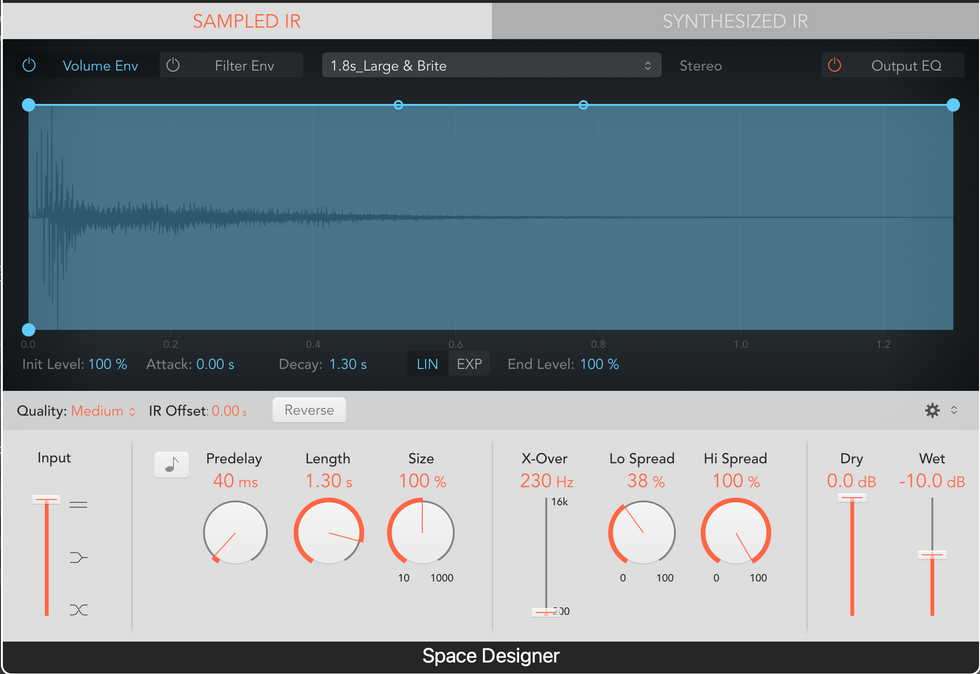
Image 3: You can get cool, if unpredictable, results by dropping random audio files into an impulse response reverb like Logic Pro’s Space Designer.
Theoretically, you need a hi-fi PA system to amplify the needed tones in the target space, and good microphones to capture the results. But not always! I’ve captured cool IRs in my travels with nothing more than an iPhone and a spring-loaded clipboard in lieu of the traditional starter pistol. I’ve even obtained decent results by clacking a couple of stones together.
Clip 9 — A Guitarist’s Guide to Reverb Plug-ins by premierguitar
Clip 9 includes quick and dirty IRs that I captured in a Neolithic cave painting site in France, a thousand-year-old ancient Anasazi ball court in Arizona, an ancient Greek stone quarry, a 19th-century limestone kiln in Death Valley, and the inside of an acoustic guitar.
You can also get interesting, if unpredictable, results loading random audio files into the IR reverb.
Clip 10 — A Guitarist’s Guide to Reverb Plug-ins by premierguitar
Clip 10 features a dry guitar snippet, followed by bizarre reverb effects generated by drum loops, synth tones, and noises.
New sounds, new spaces. Using reverb plug-ins can be incredibly simple. Often it’s just a matter of scrolling through factory presets, or making basic balance and decay time adjustments. You can also use them in endlessly creative ways. Whatever your goals, I hope this article helps you find exactly the sounds you seek.
